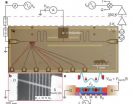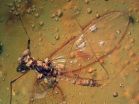(Press-News.org) Qubit-based computing exploiting spooky quantum effects like entanglement and superposition will speed up factoring and searching calculations far above what can be done with mere zero-or-one bits. To domesticate quantum weirdness, however, to make it a fit companion for mass-market electronic technology, many tricky bi-lateral and multi-lateral arrangements---among photons, electrons, circuits, cavities, etc.---need to be negotiated.
A new milestone in this forward march: a Princeton-Joint Quantum Institute (JQI) collaboration announces the successful excitation of a spin qubit using a resonant cavity. The circuit, via the cavity, senses the presence of the qubit as if it were a bit of capacitance. This result, published this week in Nature magazine (*), points toward the eventual movement of quantum information over "bus" conduits much as digital information moves over buses in conventional computers.
QUBIT CATALOG
A qubit is an isolated system---a sort of toggle---which is maintained simultaneously in a mixture of two quantum states. Qubits come in many forms, such as photons in either of two polarization states, or atoms oriented in either of two states, or superconducting circuits excited in either of two ways.
One promising qubit platform is the quantum dot, a tiny speck of semiconducting material in which the number of electrons allowed in or out can be severely controlled by nearby electrodes. In a charge qubit the dot can co-exist in states where one or zero electrons are in the dot. In a spin qubit, two electrons (sitting in two neighboring dots), acting like a molecule, possess a composite spin which can be up or down.
Quantum dots are easy to fabricate using established semiconductor technology. This gives them an advantage over many other qubit modes, especially if you want to build an integrated qubit chip with many qubits in proximity. One drawback is that qubits in a dot are harder to protect against outside interference, which can ruin the delicate quantum processing of information. An example of this unwanted decoherence is the magnetic interaction of the electron "molecule" with the nuclei of the very atoms that make up the dot.
Another challenge is to control or excite the qubit in the first place. That is, the qubit must be carefully incited into its two-states-at-once condition, the technical name for which is Rabi oscillation. The Princeton-JQI (**) work artfully addresses all these issues.
CIRCUIT QED
Indeed, the present work is another chapter in the progress of knowledge about electromagnetic force. In the 19th century James Clerk Maxwell set forth the study of electrodynamics in its classic form. In the early and mid 20th century a quantum version of electrodynamics (QED) was established which also, incidentally, accommodated the revolutionary idea of antimatter and of the creation and destruction of elementary particles.
More recently QED has been extended to the behavior of electromagnetic waves within metal circuits and resonant cavities. This cavity-QED or circuit-QED (cQED), provides a handy protocol for facilitating a traffic between qubits and circuits: excitations, entanglement, input and readout, teleportation (movement of quantum information), computational logic, and protection against decoherence.
Forty years ago this effort to marry coherent quantum effects with electronics was referred to as quantum electronics. The name used nowadays has shifted to quantum optics. "With the advent of the laser, the focus moved into the optical domain," says Jacob Taylor, a JQI fellow and NIST physicist. "It is only in the past few years that the microwave domain – where electronics really function – has come into its own, returning quantum optics to its roots in electrical circuits."
Cavities are essential for the transportation of quantum information. That's because speed translates into distance. Qubits are ephemeral; the quantum information they encode can dissipate quickly (over a time frame of nanoseconds to seconds) and all processing has to be done well before then. If, moreover, the information has to be moved, it should be done as quickly as possible. Nothing goes faster than light, so transporting quantum information (at least for moving it from one place to another within a computer), or encoding the information, or entangling several qubits should be done as quickly as possible. In this way information or processing in more distant nodes can take place.
SPIN-ORBIT COUPLING
The JQI part of this spin-qubit collaboration, Jacob Taylor, earlier this year participated in research that established a method for using a resonant cavity to excite a qubit consisting of an ion held simultaneously in two spin states. The problem there was a mismatch between the frequency at which the circuit operated and the characteristic frequency of the ion oscillating back and forth between electrodes. The solution was to have the circuit and ion speak to each other through the intermediary of an acoustic device. (See press release at http://www.jqi.umd.edu/news/302-quantum-conveyance-electrical-circuits-talk-to-single-atoms.html )
The corresponding obstacle in the JQI-Princeton experiment is that the circuit (in effect a microwave photon reflecting back and forth in a resonant cavity) exerts only a weak magnetic effect upon the electron doublet in the quantum dot. The solution: have the cavity influence the physical movement of the electrons in the dot---a more robust form of interaction (electrical in nature)---rather than the interact with the electrons' spin (magnetic force).
Next this excitation is applied to the spin of the electron doublet (the aspect of the doublet which actually constitutes the quantum information) via a force called spin-orbit coupling. In this type of interaction the physical circulation of the electrons in the dot (the "orbit" part) tangles magnetically with the spins of the nuclei (the "spin" part of the interaction) in the atoms composing the dot itself.
It turns out this spin-orbit coupling is much stronger in indium-arsenide than in the typical quantum dot material of gallium-arsenide. This it was that material science was an important ingredient in this work, in addition to contributions from the physics and electrical engineering departments at Princeton.
To recap: an electrical circuit excites the dot electrically but the effect is passed along magnetically to the qubit in the dot when the electrons in the dot move past and provoke an interaction with the nuclei in the InAs atoms. Thus these qubits deserve to be called the first spin-orbit qubits in a quantum dot.
The influence works both ways. Much as the presence of a diver on the end of a diving board alters the resonant frequency of the board, so the presence of the spin qubit alters the resonant frequency of the cavity, and so its presence can be senses. Conversely, the alteration, effected by the spin-orbit interaction, can be used to excite the qubit, at rates of a million per second or more.
Previously a quantum-dot-based charge qubit was excited by a cavity. So why was it important to make a quantum-dot qubit based on spin? "The spins couple weakly to the electrical field, making them much harder to couple to than a charge," said Taylor. "However, it is exactly this property which also makes them much better qubits since it is precisely undesired coupling to other systems, which destroys quantum effects. With a spin-based qubit, this is greatly suppressed."
INFORMATION:
See related JQI press releases:
http://www.jqi.umd.edu/news/302-quantum-conveyance-electrical-circuits-talk-to-single-atoms.html
Quantum longitude: http://www.jqi.umd.edu/news/345-quantum-longitude.html
(*) "Circuit Quantum Electrodynamics with a Spin Qubit," K. D. Petersson, L. W. McFaul, M. D. Schroer,
M. Jung, J. M. Taylor, A. A. Houck, and J. R. Petta. Nature, 18 October 2012.
(**) The Joint Quantum Institute is operated jointly by the National Institute of Standards and Technology in Gaithersburg, MD and the University of Maryland in College Park.
Press contact at JQI: Phillip F. Schewe, pschewe@umd.edu, 301-405-0989. http://jqi.umd.edu/
Bus service for qubits
Spin-orbit qubits are right at home in electrical circuits
2012-10-18
ELSE PRESS RELEASES FROM THIS DATE:
Study: Nearly 4 out of 10 lesbians not routinely screened for cervical cancer
2012-10-18
ANAHEIM, Calif. – Oct.17, 2012. Nearly 38 percent of lesbians polled in a national survey were not routinely screened for cervical cancer, putting them at risk of developing a highly preventable cancer, according to a University of Maryland School of Medicine study being presented at the 11th Annual AACR International Conference on Frontiers in Cancer Prevention Research. Cervical cancer is caused by a sexually transmitted virus, the human papillomavirus (HPV), and can be detected through regular Pap smears.
The percentage of lesbians not being screened as recommended ...
New model reconciles the Moon's Earth-like composition with the giant impact theory of formation
2012-10-18
The giant impact believed to have formed the Earth-Moon system has long been accepted as canon. However, a major challenge to the theory has been that the Earth and Moon have identical oxygen isotope compositions, even though earlier impact models indicated they should differ substantially. In a paper published today in the journal Science online, a new model by Southwest Research Institute (SwRI), motivated by accompanying work by others on the early dynamical history of the Moon, accounts for this similarity in composition while also yielding an appropriate mass for Earth ...
Proof at last: Moon was created in giant smashup
2012-10-18
It's a big claim, but Washington University in St. Louis planetary scientist Frédéric Moynier says his group has discovered evidence that the Moon was born in a flaming blaze of glory when a body the size of Mars collided with the early Earth.
The evidence might not seem all that impressive to a nonscientist: a tiny excess of a heavier variant of the element zinc in Moon rocks. But the enrichment probably arose because heavier zinc atoms condensed out of the roiling cloud of vaporized rock created by a catastrophic collision faster than lighter zinc atoms, and the remaining ...
Giant impact scenario may explain the unusual moons of Saturn
2012-10-18
SANTA CRUZ, CA--Among the oddities of the outer solar system are the middle-sized moons of Saturn, a half-dozen icy bodies dwarfed by Saturn's massive moon Titan. According to a new model for the origin of the Saturn system, these middle-sized moons were spawned during giant impacts in which several major satellites merged to form Titan.
Erik Asphaug, professor of Earth and planetary sciences at the University of California, Santa Cruz, will present this new hypothesis October 19 at the annual meeting of the Division for Planetary Sciences of the American Astronomical ...
The evolutionary origins of our pretty smile
2012-10-18
It takes both teeth and jaws to make a pretty smile, but the evolutionary origins of these parts of our anatomy have only just been discovered, thanks to a particle accelerator and a long dead fish.
All living jawed vertebrates (animals with backbones, such as humans) have teeth, but it has long been thought that the first jawed vertebrates lacked pearly gnashers, instead capturing prey with gruesome scissor-like jaw-bones.
However new research, led by the University of Bristol and published today in Nature, shows that these earliest jawed vertebrates possessed teeth ...
Epigenetic analysis of stomach cancer finds new disease subtypes
2012-10-18
DURHAM, N.C. – Researchers at the Duke-NUS Graduate Medical School in Singapore have identified numerous new subtypes of gastric cancer that are triggered by environmental factors.
Reported in the Oct. 17, 2012, issue of the journal Science Translational Medicine, the findings are based on the science of epigenetics, a study of gene activity. The insights into the complexities of stomach cancer could lead to better treatment approaches for the second leading cancer killer in the world, behind lung cancer.
"Gastric cancer is a heterogenous disease with individual patients ...
Physical activity shown to help young and elderly alike with lower-leg coordination
2012-10-18
An Indiana University study that examined the effect of age and physical activity on lower leg muscle reflexes and coordination concluded that participation in physical activity was beneficial for lower leg muscle coordination across both sides of the body in both young and older study participants. Lower limb muscle communication is essential for everyday tasks, such as walking, balancing, and climbing stairs.
"The results of this study suggest that participation in physical activity contributes to greater crossed-spinal reflex stability in both young and elderly subjects," ...
Springtail bugs may have travelled on the wings of mayflies
2012-10-18
A mayfly trapped in 16-million-year-old-amber reveals a hitchhiking springtail, a wingless arthropod that is amongst the most commonly found bugs all over the world. The new research, published Oct 17 in the open access journal PLOS ONE led by David Penney from the University of Manchester, UK, is the first to show that springtails travelled on winged insects like mayflies, and only the second example of this mode of travel by springtails in the past or present.
Springtails are among the most abundant group of arthropods, found in large numbers in soil all over the world. ...
Dolphins can remain alert for up to 15 days at a time with no sign of fatigue
2012-10-18
Dolphins sleep with only one half of their brains at a time, and according to new research published Oct. 17 in the open access journal PLOS ONE, this trait allows them to stay constantly alert for at least 15 days in a row. Brian Branstetter from the National Marine Mammal Foundation and colleagues found that dolphins can use echolocation with near-perfect accuracy continuously for up to 15 days, identifying targets and monitoring their environment.
The researchers studied 2 dolphins, one male and one female, and found that they were capable of this task with no signs ...
Impact of autism may be different in men and women
2012-10-18
Men and women with autism spectrum conditions (ASC) may show subtle but significant differences in the cognitive functions impacted by the condition, according to new research published Oct 17 by Meng-Chuan Lai and colleagues from the Autism Research Centre at the University of Cambridge, UK in the open access journal PLOS ONE.
Though individuals with autism show sex-specific differences in serum biomarkers, genetics and brain anatomy, little is known about any sex-dependent differences in cognition caused by ASC. Following their previous report on behavioral sex differences ...
LAST 30 PRESS RELEASES:
Making lighter work of calculating fluid and heat flow
Normalizing blood sugar can halve heart attack risk
Lowering blood sugar cuts heart attack risk in people with prediabetes
Study links genetic variants to risk of blinding eye disease in premature infants
Non-opioid ‘pain sponge’ therapy halts cartilage degeneration and relieves chronic pain
AI can pick up cultural values by mimicking how kids learn
China’s ecological redlines offer fast track to 30 x 30 global conservation goal
Invisible indoor threats: emerging household contaminants and their growing risks to human health
Adding antibody treatment to chemo boosts outcomes for children with rare cancer
Germline pathogenic variants among women without a history of breast cancer
Tanning beds triple melanoma risk, potentially causing broad DNA damage
Unique bond identified as key to viral infection speed
Indoor tanning makes youthful skin much older on a genetic level
Mouse model sheds new light on the causes and potential solutions to human GI problems linked to muscular dystrophy
The Journal of Nuclear Medicine ahead-of-print tip sheet: December 12, 2025
Smarter tools for peering into the microscopic world
Applications open for funding to conduct research in the Kinsey Institute archives
Global measure underestimates the severity of food insecurity
Child survivors of critical illness are missing out on timely follow up care
Risk-based vs annual breast cancer screening / the WISDOM randomized clinical trial
University of Toronto launches Electric Vehicle Innovation Ontario to accelerate advanced EV technologies and build Canada’s innovation advantage
Early relapse predicts poor outcomes in aggressive blood cancer
American College of Lifestyle Medicine applauds two CMS models aligned with lifestyle medicine practice and reimbursement
Clinical trial finds cannabis use not a barrier to quitting nicotine vaping
Supplemental nutrition assistance program policies and food insecurity
Switching immune cells to “night mode” could limit damage after a heart attack, study suggests
URI-based Global RIghts Project report spotlights continued troubling trends in worldwide inhumane treatment
Neutrophils are less aggressive at night, explaining why nighttime heart attacks cause less damage than daytime events
Menopausal hormone therapy may not pose breast cancer risk for women with BRCA mutations
Mobile health tool may improve quality of life for adolescent and young adult breast cancer survivors
[Press-News.org] Bus service for qubitsSpin-orbit qubits are right at home in electrical circuits




